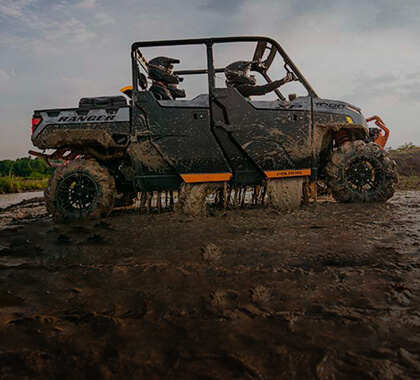Proper Storage Methods For Your Polaris Ranger
Jan 12th 2020

You’ve devoted a fair amount of capital to your Polaris Ranger, so why not go the extra mile to protect your investment? Sure damage might occur on the trail or when the machine is in use, but that is just part of the game and a cost of doing business. What isn’t justifiable, however, is damage, ware, and the depreciation that is unavoidable when you leave your machine out and exposed to the elements.
A stock ranger should never be left outside unprotected. Add a navigational system, communication units, subwoofers, UTV speakers, and other delicate electronic accessories to the mix and you’ve got even more of a reason to keep your rig sheltered. Some might argue that you probably should build a storage building of some kind before putting $20,000 into a side-by-side. But for many riders with limited space or a fixed income, this just isn’t an option. Whatever the case may be for you and your situation, here are some ideas for storing your Polaris Ranger when it’s not in use.
Storing Your Ranger Indoors

Putting your Polaris Ranger inside a garage is an obvious way to fend off the ravages of Mother Nature. If you don’t have a garage, a pole barn or insulated pole shed will do the trick. But if all you have is a small patch of land, a simple lean-to structure or a pop up carport can also work. We’ve even seen people store their Rangers in 20' shipping containers.
Indoor storage is beneficial not only because it keeps your Ranger out of the wind, rain, snow and sun, but also because it deters small animals from using your side-by-side as a free AirBnB. Rats, mice, and rabbits all love stuff like this. They climb up under the chassis and build nests where it suites them, chewing on wires, gnawing threw plastic, and dropping excrement with blatant disregard.
This is not to say, however, that vermin aren’t an issue inside as well. We know people that keep their UTVs in a locked shop, surrounded by a locked fence, and with motion alerts on their phones to prevent theft, all the while neglecting the more plausible damage that will undoubtably occur should a few stay rodents manage to get inside.
Storing Your Ranger Outdoors

For those that don’t have a shop, shed, or drive-in basement to store their Polaris Rangers in, the next best thing a UTV owner can do for their machine is give it partial coverage. Garage roofs and covered patios work well, and as we stated earlier, a car port is an easy solution for UTV storage. You can have a one-car carport put up for less then a grand, and put steel on the sides and back wall. Most companies will charge a lot to enclose them, but it’s easy and cheap to do yourself.
Enclosed trailers are another solution that work great for both storing and hauling a Polaris Ranger, but again, for those without an excessive amount of zeros in their bank account, things like this are out of the question. So if you’re wanting to protect your machine with the least amount of money, a UTV storage cover is your best bet. Go to a Can-Am dealership and get a breathable Defender cover that the Crew Lonestar or Limited machines are shipped in.
Other Polaris Ranger covers work as well, so long as they have the elastic bands that go all the way to the bottom of the tires with the straps underneath. You should avoid using regular tarps unless you’re covering your machine from snow, as tarps tend to trap moisture underneath.

Making sure that you cover your machine when trailering it is also important. Road salt, fast-flying sand, and other impacts from the open highway will dent, ding, and damage your Ranger when in tow. It should be noted, however, that not all storage covers are meant to be used for trailering. The fabric by the straps may start to tear if you use a storage cover as a trailering cover. The fabric will unravel and the cover might fall apart completely.
But even Polaris Ranger trailering covers may fail if you don’t secure it or the machine properly. Nine times out of ten, when you hear someone saying that their trailering cover is junk, it’s typically due to improper use, not an inferior product. So strap your trailering covers down tight, use the built-in ratchet strap around the bottom, and crank the cinch strap down low from side to side to keep everything nice and secure.



